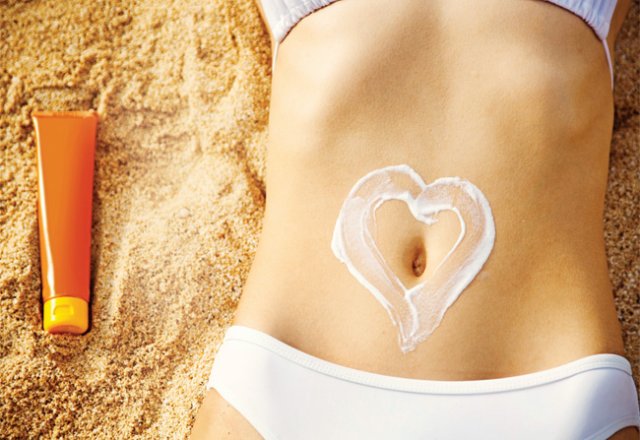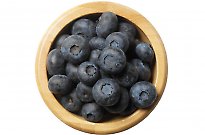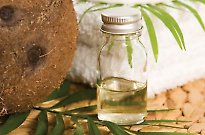
Natural sunscreen alternatives

Foods to prevent skin cancer
Louise Wedgewood finds out which natural alternatives can help ward off ageing and skin cancer.
Good news arrived in July last year with the CSIRO’s announcement that it’s developing a sunscreen inspired by the Great Barrier Reef. This safe and effective sunscreen mimics the natural filters that the coral uses to shield itself from the sun to block both UVA rays (which play a major role in skin ageing and wrinkling) and UVB rays (the chief cause of skin reddening and sunburn).
“The filters are clear in colour, virtually odourless and very stable,” says CSIRO research scientist Dr Mark York.
If you’re like most Australians, you’re longing for a better sunscreen. Research released in August 2013 shows that only 37 per cent of us bought sunscreen in an average six months, even fewer than in previous years despite the fact that increasing numbers of Australians are now worried about skin cancer.
You have good reason to worry. Australia is the skin cancer capital of the world, and chances are that you and I will be among the two out of every three Australians diagnosed with skin cancer before we’re 70. Australians’ lack of enthusiasm for sunscreen is certainly not because we’re using other ways to avoid sun-damaged skin as the Medical Journal of Australia reported in May last year after researchers discovered many of us continue to get sunburnt.
A major reason behind our reluctance to use sunscreen is the potential danger of some common ingredients. Chemical sunscreens such as octyl methoxycinnamate, 4-methylbenzylidene camphor and benzophenone-3 are likely endocrine disrupting chemicals (EDCs). An investigation by consumer group Choice reported that these three chemicals “have been found in some studies to have developmental and reproductive effects as well as thyroid effects”. As a safer alternative, Choice recommends physical sunscreens like zinc and titanium oxides to reflect, rather than absorb, UV radiation. However, when physical sunscreens are made transparent by reducing them to nanoparticles, these tiny particles may be able to be penetrate the–skin and be absorbed by living cells. The safety of nanoparticles has not been proven and many people are concerned about their possible dangers.
Foods to prevent skin cancer
You don’t have to be a scientist to know that fruits and vegetables have hundreds of health benefits, and preventing sun damage is one of them. When certain types of skin cells – keratinocytes – are exposed to too much sunlight, the resulting oxidative stress can overwhelm our supply of antioxidants. Antioxidants work by scavenging for and neutralising free radicals, reducing our risk of cancer and skin damage like wrinkles, pigmentation and loss of elasticity. Research confirms that eating more foods rich in antioxidants helps our bodies combat UV-induced stress.
Among the vitamins and minerals, vitamins C and E and selenium are three important antioxidants. Some of the most potent foods to boost your intake of vitamin C are capsicum, dark leafy greens, pawpaw, guava and strawberries. For vitamin E, eat almonds, sunflower seeds and olives, and choose mushrooms, Brazil nuts and fish (especially tuna) for selenium.
The same substances that give fruits and vegetables their beautiful colours also help protect our skin from the sun. Carotenoids are a group of antioxidants that give plants their red, orange and yellow colours. They include alpha- and beta-carotene, lycopene and lutein. You’ve probably know pumpkin and carrots are great sources of alpha- and beta-carotenes. If you’re not sure where to get more lutein on your plate, no need to worry if you’re already eating a range of deep green, orange and yellow fruits and vegetables along with egg yolks. Cooked tomatoes are well known as the go-to for lycopene – think tomato paste and pasta sauce. The sun damage-fighting properties of lycopene were demonstrated in a three-month study where participants ate 55 gm tomato paste in olive oil every day, and their skin subsequently tolerated longer exposure to UV radiation before starting to burn.
Along with carotenoids, other antioxidants called flavonoids (from the Latin word flavus, meaning yellow) also create the bright red, orange and yellow colours of many fruits and vegetables. Plain old carrots and capsicum contain flavonoids but so too does cacao. That’s right, you can eat your way to youthfulness and health, one square of dark chocolate at a time. In a German study, women were asked to drink hot chocolate every day for three months and their skin developed greater resistance to UV radiation. Green tea is another sun –damage-fighting beverage thanks to a flavonoid called catechin.
Many plants with dark blue, purple, red or black fruits and leaves get their pigments from different antioxidants called anthocyanins. Eat more berries and cherries, and vegetables like purple broccoli and eggplant. The darker the colour, the richer the anthocyanin content.
One nutrient that reduces the risk of skin cancer but is difficult to get from fruit and vegetables is omega-3. The American Journal of Clinical Nutrition published a study showing that omega-3 reduces the sunlight-induced suppression of the immune system, which hampers the body’s ability to fight cancer and infection. Lead researcher Professor Rhodes said, “this study adds to the evidence that omega-3 is a potential nutrient to protect against skin cancer”. Your body can’t make these essential fatty acids so you have to eat them – a great excuse to order the salmon at dinner, or eat sardines for breakfast and take tuna to work for lunch. Apart from seafood, walnuts are also a nutritious source of omega-3s.
It can’t be a coincidence that most of the foods richest in the substances that protect us from UV radiation are at their peak during summer. Putting it all together, your sun damage-fighting summer menu could be as tasty as this:
- Eggs poached in cooked tomatoes and diced red capsicum with a cup of green tea for breakfast
- A handful of Brazil nuts, walnuts and almonds plus some blueberries for morning tea
- A salad of dark leafy greens like spinach and kale, mushrooms, capsicum, grated carrot, olives and tuna with a sprinkling of sunflower seeds for lunch
- Guava and pawpaw juice for afternoon tea
- Any balanced dinner
A bowl of fresh cherries dipped in dark chocolate for dessert.
The perfect sunscreen that’s both effective and completely safe, just like the perfect contraception, is still in development. But abstinence (or staying indoors 24/7) is not an option. You can still enjoy the natural world outdoors with the aid of nutritious food, sensible clothing and leafy trees, and back up your skin’s natural protection with the best sunscreens currently available. Why not enjoy this summer and care for your skin at the same time by reclining under a shady tree with a bowl of berries and an iced green tea? You’ll be feeling as young and fresh as your skin looks.
NEXT: Common skin problems and their causes>>
Photo credit: Thinkstock


